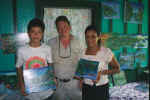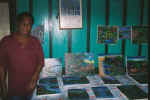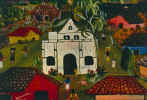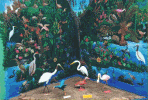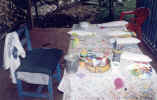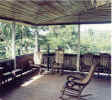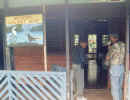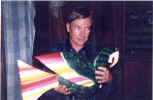 The Gospel According to Solentiname
The Gospel According to Solentiname
by Ernesto Cardenal
Every Sunday, on the Island of Solentiname, a withdrawn oasis on Nicaragua
Lake, we hold a discussion with campesinos instead of a sermon on the Gospel.
The campesinos’ comments are usually more incisive than those of many
theologians, but as guileless as the Gospel itself. This is not odd: the
Gospel, or "good news" was written for and by people similar to
them.
Some friends advised me not to let these
commentaries fade away, but to collect and publish them in a book. This is
that book. I first began collecting them by memory and went back as far as
possible. Then, in a more pragmatic sense, we used a tape recorder.
Many of these interpretations were offered at
church, at Sunday mass - also, in the straw hut, where we held our meetings
and our community lunch after mass. We often held our mass and discussion of
the Gospel here under the open sky, at other islands, or at a small hamlet by
a beautiful river with lush, tropical vegetation.
Every Sunday, we give each attendee a copy of
the Gospel. That is, those who can read. We have a few who cannot read -
mainly the elders. That’s because they come from islands far from the
school. Someone who reads better, usually a younger boy or girl, reads us the
chapter that is to be studied. Then, we offer our commentaries line by line.
Thirty-eight islands make up the Solentiname
archipelago - some are quite small and only the larger islands are inhabited.
There are about a thousand people living there. That makes around ninety
families. Homes are typically straw huts that are scattered, one far from the
other, on these islands’ beaches. Our community or laity monastery, Our Lady
of Solentiname, is situated on the tip of the biggest island. The Colombian
poet, William Agudelo, his wife, Teresita, and their two small children, Irene
and Juan are part of this community. Also, three youngsters were born on these
islands, Alejandro, Elbis and Laureano. Communication with the outside world
is not frequent and our meditation is not disturbed in this place. It’s not
easy to reach and lies, thank God, far from business and tourism routes.
Not all of the inhabitants on these islands
come to mass. Many don’t because they don’t have a boat.
Some don’t because they have lost their
devotion to the saints. Others don’t because of the influence of the
anticommunist propaganda and perhaps because of fear. Not all of those who
come, take part in these commentaries. There are some who speak often.
Marcelino is mystical. Olivia is more
theological. Rebecca, Marcelino’s wife, always dwells on love. Laureano
relates everything to the revolution. Elbis is concerned with tomorrow’s
perfect society. Felipe, another youngster, always has the struggle of the
proletariat in mind. Tomás Peña, his dad, cannot read but speaks with great
wisdom. Alejandro, Olivia’s son, is a young leader and his comments are
usually words of counsel for everybody, but particularly for the young. Pancho
is a conservative. Julio Mairena constantly defends equality. Oscar, his
brother, always speaks of unity. They and everybody else who speaks often and
says important things, and those who seldomly speak but also say important
things, and those compañeros like William and Teresita that have participated
in these discussions, they are the authors of this book.
It’s more accurately said that the true
author of this book is the Holy Spirit that has inspired these commentaries.
The campesinos in Solentiname very well know that He is the one who makes them
speak. He is the same who inspired the Gospel. The Holy Spirit is God’s
spirit living among his people - He is who Oscar would call the spirit of
community cohesion, and who Alejandro the spirit of serving others, and Elbis
the spirit of the future society, and Felipe the spirit of the struggle of the
proletariat, and Julio the spirit of equality and common goods, and Laureano
the spirit of the revolution, and Rebeca the spirit of love.
La Esquina del Lago
Hotel Jungle
River Lodge in National Park Reserva de vida silvestre Los Guatuzos,
Bocana de Rio
Frio,
San Carlos, Rio San Juan, Nicaragua.
Tel
( 505 ) 88 49 06 00
( 506 ) 88 42 76 73
E-MAIL
Click
Site map
Index/Welcome
Home
Location of Lodge
How to get there
Hotel Lodging &
Meals
What's around:
Jungle
River Scenery
History
Arts
Activities and Tours:
Sport Fishing
Kayak Adventures
Bird
watching
Pricing:
Hotel
& Restaurant
Activities and
Tours
References:
Testimonials
|
HOME
Hotel, Tours La Esquina del
Lago, Jungle River Lodge
Rio San Juan Nicaragua,
E MAIL |
